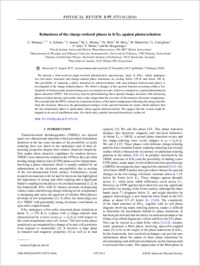Robustness of the charge-ordered phases in ${\mathrm{IrTe}}_{2}$ against photoexcitation
- Monney, Claude Physik-Institut, Universität Zürich, Switzerland - Département de Physique and Fribourg Center for Nanomaterials, Université de Fribourg, Switzerland
- Schuler, A. Physik-Institut, Universität Zürich, Switzerland
- Jaouen, Thomas Département de Physique and Fribourg Center for Nanomaterials, Université de Fribourg, Switzerland
- Mottas, Marie-Laure Département de Physique and Fribourg Center for Nanomaterials, Université de Fribourg, Switzerland
- Wolf, Thomas Institute of Solid State Physics, Karlsruhe Institute of Technology, Germany
- Merz, M. Institute of Solid State Physics, Karlsruhe Institute of Technology, Germany
- Muntwiler, Matthias Paul Scherrer Institut, Villigen PSI, Switzerland
- Castiglioni, L. Physik-Institut, Universität Zürich, Switzerland
- Aebi, Philipp Département de Physique and Fribourg Center for Nanomaterials, Université de Fribourg, Switzerland
- Weber, F. Institute of Solid State Physics, Karlsruhe Institute of Technology, Germany
- Hengsberger, M. Physik-Institut, Universität Zürich, Switzerland
-
07.02.2018
Published in:
- Physical Review B. - 2018, vol. 97, no. 7, p. 075110
English
We present a time-resolved angle-resolved photoelectron spectroscopy study of IrTe2, which undergoes two first-order structural and charge-ordered phase transitions on cooling below 270 K and below 180 K. The possibility of inducing a phase transition by photoexcitation with near-infrared femtosecond pulses is investigated in the charge-ordered phases. We observe changes of the spectral function occurring within a few hundreds of femtoseconds and persisting up to several picoseconds, which we interpret as a partial photoinduced phase transition (PIPT). The necessary time for photoinducing these spectral changes increases with increasing photoexcitation density and reaches time scales longer than the rise time of the transient electronic temperature. We conclude that the PIPT is driven by a transient increase of the lattice temperature following the energy transfer from the electrons. However, the photoinduced changes of the spectral function are small, which indicates that the low- temperature phase is particularly robust against photoexcitation. We suggest that the system might be trapped in an out-of-equilibrium state, for which only a partial structural transition is achieved.
- Faculty
- Faculté des sciences et de médecine
- Department
- Département de Physique
- Language
-
- English
- Classification
- Physics
- License
- License undefined
- Identifiers
-
- RERO DOC 306917
- DOI 10.1103/PhysRevB.97.075110
- Persistent URL
- https://folia.unifr.ch/unifr/documents/306284
Statistics
Document views: 74
File downloads:
- aeb_rco.pdf: 120
